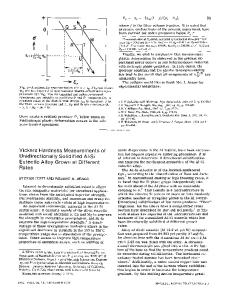Study on Copper Precipitation under Electron Irradiation in FeCu Model Alloys by Using Vickers Hardness Measurements
- PDF / 113,284 Bytes
- 6 Pages / 612 x 792 pts (letter) Page_size
- 37 Downloads / 363 Views
1043-T09-04
Study on Copper Precipitation under Electron Irradiation in FeCu Model Alloys by Using Vickers Hardness Measurements Shou Nakagawa1, Fuminobu Hori1, Hirotaka Ohno1, Norito Ishikawa2, Ryuichiro Oshima3, Michiharu Kitagawa3, and Akihiro Iwase1 1 Osaka Prefecture University, Sakai, 599-8531, Japan 2 Japan Atomic Energy Agency, Tokai-mura, 319-1195, Japan 3 Osaka Nuclear Science Association, Osaka, 541-0057, Japan ABSTRACT Three kinds of Fe-based model alloys, Fe-0.02wt%Cu, Fe-0.6wt%Cu, and Fe-1.2wt%Cu were irradiated with 2MeV electrons at 250oC. After the irradiation, the hardness was measured using a micro Vickers hardness tester at room temperature. It was found that the hardness change by electron irradiation is proportional to the product of the copper concentration and the square root of electron fluence. The result is discussed in terms of the dispersion strengthening by Cu precipitates. INTRODUCTION In light water reactors, a pressure vessel is one of the most important barriers in the nuclear power plants. Hardening and embrittlement of vessel steels are the most important phenomena responsible for the limitation of light water reactor lifetime. It is well known that embrittlement of the pressure vessels steels during irradiation is partly due to copper precipitation, because Cu precipitates act as obstacles against the dislocation motions[1,2]. The definite understanding of this phenomenon is important for the evaluation of the lifetime of light water reactors. In the present experiment, we have studied the hardening of FeCu model alloys under energetic electron irradiation by using micro Vickers hardness measurement. EXPERIMENT Specimens used in the experiment were prepared from three kinds of FeCu alloys with Cu concentration of 0.02, 0.6 and 1.2 wt%. The specimens were annealed at 850oC, followed by quenching into 0 oC water. This treatment ensured a homogeneous distribution of Cu atoms in Fe matrices. The final dimension of each specimen was 5x5x1mm3. The specimens were irradiated at 250oC with 2 MeV electrons using a single-ended accelerator at JAEA-Takasaki. After the irradiation, the micro Vickers hardness was measured as a function of electron fluence and the Cu concentration. The time interval of indentation was kept at 20 s for all the trials. RESULTS Fig.1 shows the dependence of change in Vickers microhardness on electron fluence for Fe-0.02wt%Cu, Fe-0.6wt%Cu and Fe-1.2wt%Cu. The data points represent the average of 10 to 20 measurements. As shown in Fig. 1, there is little change in hardness by the irradiation for Fe0.02wt%Cu. On the other hand, irradiation-induced hardness for Fe-0.06wt%Cu and Fe1.2wt%Cu increases with increasing electron fluence, with a sublinear dependence on fluence.
80
Fe-0.02wt%Cu Fe-0.6wt%Cu Fe-1.2wt%Cu
70 60
∆Hv
50 40 30 20 10 0
0
1 1017 2 1017 3 1017 4 1017 5 1017 6 1017 7 1017 2
Electron fluence(1/cm )
Figure 1. Vickers hardness changes for Fe-0.02wt%Cu, Fe0.6wt%Cu and Fe-1.2wt%Cu specimens irradiated with 2 MeV electrons at 250oC.
In the Fig 2,
Data Loading...











